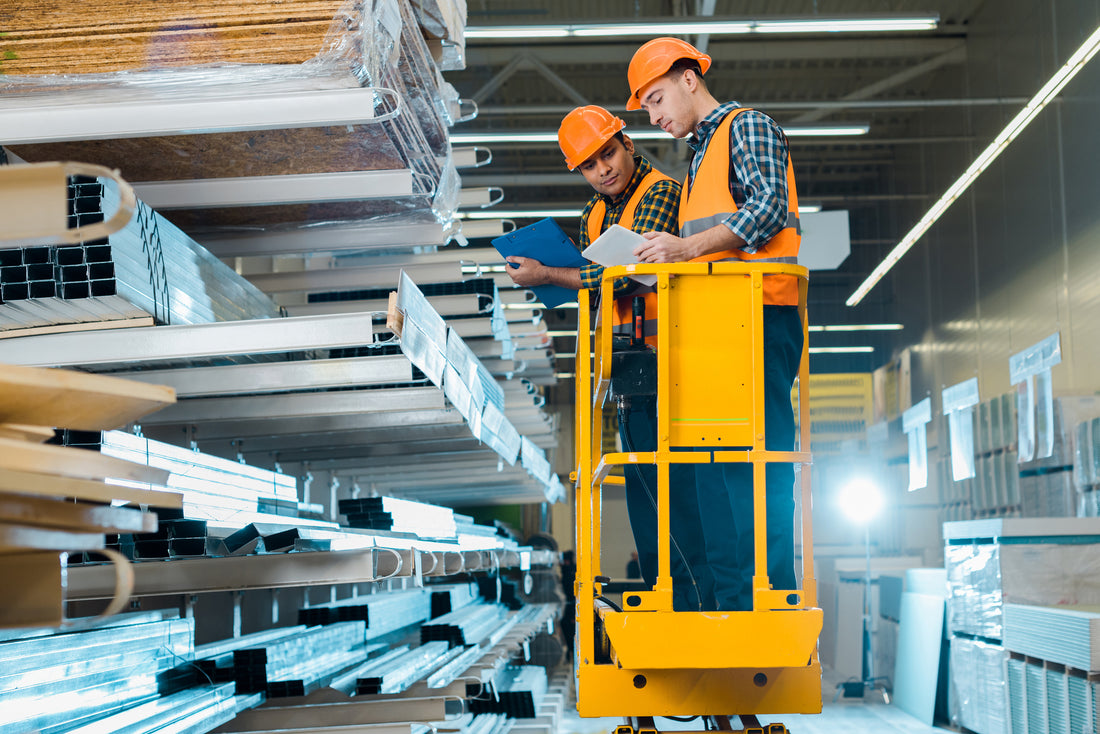Scissor lifts work wonders in all spaces, but in particular, warehouses and building maintenance. Known for the criss-crossing design that elevates a stable work platform, scissor lifts rely on a few different types of motors. From hydraulic to electric, we look at how scissor lifts operate and the unique benefits of electric scissor lifts.
How Scissor Lifts Operate
Ultimately, scissor lifts, along with any type of aerial lift, help technicians reach difficult areas. Additionally, scissor lifts offer increased stability over other aerial lifts because the criss-crossing design structure supports a larger work platform. As a result, scissor lifts provide an ideal option to complete any and all necessary work at elevated locations. Frequently, work teams leverage scissor lifts instead of ladders because of the enhanced safety features. For example, one of the basic operational rules forbids operating the lift while the platform is elevated. Finally, scissor lifts, which vary in size, are great machines for navigating between tight isles (such as in warehouses).
Regardless of the power function, all scissor lifts generally operate in the same manner. First, operators turn on the lift in order to fill the cylinders with hydraulic fluid or compressed air. As the fluid and/or air pushes through the lift, the cylinders push outward and the legs start to push apart. The work platform elevates as the fluid or air continues to flow through the cylinders contained within the criss-crossed legs of the lift. Conversely, to lower the lift, operators release the fluid or air pressure and the process reverses.
Finally, the speed of raising or lowering work platforms depends on how powerful the lift is and how much weight is on the platform. For example, the more weight puts more pressure on powering the lift. As a result, for operators that will routinely need to move heavy loads, consider a more powerful engine and lift. For more information about the power sources of scissor lifts, the following are the common types of engines.
-
Hydraulic Scissor Lifts
Hydraulic scissor lifts leverage hydraulic fluid to power and lift the platform. Hydraulic lifts are simple to use and don’t require much training, but do not provide much speed or horsepower. As a result, these lifts are ideal for simple projects.
-
Pneumatic Scissor Lifts
Pneumatic scissor lifts leverage air pressure to power and lift the platform. As a result, these lifts don’t emit any by-products, which means pneumatic lifts offer a sustainable option. However, like hydraulic lifts, they do not provide much power and are ideal for small or indoor work.
-
Diesel Scissor Lifts
Diesel scissor lifts leverage diesel fuel. As a result, these engines provide the most power of any scissor lift, which means they can carry the most weight and offer a larger work platform. Diesel lifts obviously emit fumes and are ideal for outdoor work due to the emissions and noise.
-
Electric Scissor Lifts
Electric scissor lifts leverage a battery-powered engine. As a result, electric scissor lifts provide a hybrid approach of sufficient power with a quiet engine source. For example, these lifts do not emit fumes and are less bulky than diesel lifts.
Benefits of Electric Scissor Lifts
Generally, electric scissor lifts help lower the total ownership costs. For example, relying on a battery-powered motor means no fuel costs. Additionally, as battery technology advances, electric scissor lifts provide sufficient uptime to power the standard job. Other benefits of electric scissor lifts include:
- Quieter Work Area
- Zero Emissions
- Fewer Scheduled Services
- Reduced Dependency on Hydraulic Oils
- Ideal for Indoor Use
Finally, electric scissor lifts are still scissor lifts, which means no substantial changes to the overall design of the aerial lift. Although the electric motor may be slightly less powerful than diesel engines, these lifts remain highly functional.
Safely Working with Electric Scissor Lifts
Although an electric scissor lift offers some increased safety vs a combustible engine, the same aerial lift safety procedures should always be followed.
First and foremost, operators still work at elevated spaces, which means significant risk of falling. Therefore, working safely with any type of aerial lifts means adhering to OSHA guidelines and ANSI standards. For example, these regulations which includes fall protection guidelines related to operators wearing protective gear that:
- prohibits them from falling more than 6 feet.
- prevents them from experiencing more than 1,800 pounds of arresting force.
- restricts them from contacting any lower surface.
Additionally, working safely with aerial lifts means ensuring electric scissor lifts remain in good condition. As a result, always conduct a pre-use and post-use inspection and remove any damaged lift prior to using in the field. Plus, check the essentials, every time, such as:
- Fluid Levels - ensure the oil, hydraulic, gas, brake and other fluids remain at appropriate levels based on manufacturer’s guidance.
- Tire Pressure - Check tire and wheel pressure to avoid compromising safety concerns during the operation of the device.
- Personal Safety Equipment - Ensure safety gear, such as gloves, hats, harnesses and glasses, remain in good condition.
Finally, for more information on maintaining your electric scissor lift, Aerial Equipment Parts maintains a vast inventory of replacement parts. At AEP, we are an equipment parts wholesaler that strives to provide quality parts at a reasonable price. Plus, and an important distinction about our organization, we realize it is important to speak with sales representatives that knows about your equipment. As a result, most of our reps started in our warehouse fulfilling orders and worked their way up to phone support. So, when you call AEP you will speak with someone who knows parts.
Equally important to our industry knowledge is our inventory. We maintain stocked warehouses throughout the US and ship Monday through Friday 7:00 a.m. - 3:30 p.m. CST. Plus, our parts meet or exceed the original manufacturer's quality.
For any scissor lift or aerial lift equipment question, contact us today at 303-704-7000 or contact@aerialequipmentparts.com.


